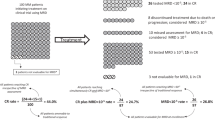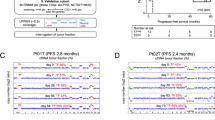Key Points
-
Outcomes of patients with multiple myeloma have improved substantially in the past decade
-
A large proportion of patients achieve a complete response to current therapies
-
More-sensitive assays for the detection of MRD are required
-
Standardization and guidelines on the use of MRD testing in clinical trials and in the clinic are required
Abstract
Outcomes for patients with multiple myeloma (MM) have improved substantially in the past decade, with improvements in both progression-free survival and overall survival. Many patients are now achieving a complete response to treatment, and consequently highly sensitive assays are needed for detection of minimal residual disease (MRD) in patients with MM. Results of multicolour flow cytometry and deep-sequencing studies suggest that among patients achieving a complete response, MRD-negative status is associated with significant improvements in progression-free survival and overall survival. Despite the increasing need for MRD testing in patients with MM, considerable heterogeneity in techniques for MRD detection hinders the clinical interpretation of their results. The criteria used to define MRD, strengths and weaknesses of the major types of tests (flow cytometry versus molecular testing), and the optimal sample type (bone marrow aspirate versus peripheral blood) are all unresolved dilemmas in MRD testing. This Review presents an overview of the various techniques for MRD detection in patients with MM. In addition, this article discusses challenges and opportunities for the routine use of MRD testing, possible future directions for clinical trials and implications for drug approval processes.
This is a preview of subscription content, access via your institution
Access options
Subscribe to this journal
Receive 12 print issues and online access
$209.00 per year
only $17.42 per issue
Buy this article
- Purchase on Springer Link
- Instant access to full article PDF
Prices may be subject to local taxes which are calculated during checkout



Similar content being viewed by others
References
Kristinsson, S. Y., Anderson, W. F. & Landgren, O. Improved long-term survival in multiple myeloma up to the age of 80 years. Leukemia 28, 1346–1348 (2014).
Turesson, I., Velez, R., Kristinsson, S. Y. & Landgren, O. Patterns of improved survival in patients with multiple myeloma in the twenty-first century: a population-based study. J. Clin. Oncol. 28, 830–834 (2010).
Kumar, S. K. et al. Continued improvement in survival in multiple myeloma: changes in early mortality and outcomes in older patients. Leukemia 28, 1122–1128 (2014).
Jakubowiak, A. J. et al. A phase 1/2 study of carfilzomib in combination with lenalidomide and low-dose dexamethasone as a frontline treatment for multiple myeloma. Blood 120, 1801–1809 (2012).
Korde, N. et al. Phase II clinical and correlative study of carfilzomib, lenalidomide, and dexamethasone followed by lenalidomide extended dosing (CRD-R) induces high rates of MRD negativity in newly diagnosed multiple myeloma (MM) patients. Blood 122, 538 (2013).
Kapoor, P. et al. Importance of achieving stringent complete response after autologous stem-cell transplantation in multiple myeloma. J. Clin. Oncol. 31, 4529–4535 (2013).
Paiva, B. et al. Multiparameter flow cytometric remission is the most relevant prognostic factor for multiple myeloma patients who undergo autologous stem cell transplantation. Blood 112, 4017–4023 (2008).
Rawstron, A. C. et al. Minimal residual disease assessed by multiparameter flow cytometry in multiple myeloma: impact on outcome in the Medical Research Council Myeloma IX Study. J. Clin. Oncol. 31, 2540–2547 (2013).
Martinez-Lopez, J. et al. Prognostic value of deep sequencing method for minimal residual disease detection in multiple myeloma. Blood 123, 3073–3079 (2014).
Mateos, M. V. et al. Lenalidomide plus dexamethasone for high-risk smoldering multiple myeloma. N. Engl. J. Med. 369, 438–447 (2013).
Ahn, I. E., Mailankody, S., Korde, N. & Landgren, O. Dilemmas in treating smoldering multiple myeloma. J. Clin. Oncol. http://dx.doi.org/10.1200/JCO.2014.56.4351.
Flanders, A., Stetler-Stevenson, M. & Landgren, O. Minimal residual disease testing in multiple myeloma by flow cytometry: major heterogeneity. Blood 122, 1088–1089 (2013).
Roschewski, M. et al. Minimal residual disease: what are the minimum requirements? J. Clin. Oncol. 32, 475–476 (2014).
US Food and Drug Administration. FDA-NCI roundtable: symposium on flow cytometry detection of minimal residual disease in multiple myeloma [online], (2014).
Landgren, O. et al. Flow cytometry detection of minimal residual disease in multiple myeloma: lessons learned at FDA-NCI roundtable symposium. Am. J. Hematol. 89, 1159–1160 (2014).
Blade, J. et al. Criteria for evaluating disease response and progression in patients with multiple myeloma treated by high-dose therapy and haemopoietic stem cell transplantation. Myeloma Subcommittee of the EBMT European Group for Blood and Marrow Transplant. Br. J. Haematol. 102, 1115–1123 (1998).
Rajkumar, S. V. et al. Consensus recommendations for the uniform reporting of clinical trials: report of the International Myeloma Workshop Consensus Panel 1. Blood 117, 4691–4695 (2011).
Mailankody, S. et al. Molecular and biologic markers of progression in monoclonal gammopathy of undetermined significance to multiple myeloma. Leuk. Lymphoma 51, 2159–2170 (2010).
Rawstron, A. C. et al. Flow cytometric disease monitoring in multiple myeloma: the relationship between normal and neoplastic plasma cells predicts outcome after transplantation. Blood 100, 3095–3100 (2002).
Rawstron, A. C. et al. Report of the European Myeloma Network on multiparametric flow cytometry in multiple myeloma and related disorders. Haematologica 93, 431–438 (2008).
Paiva, B. et al. Comparison of immunofixation, serum free light chain, and immunophenotyping for response evaluation and prognostication in multiple myeloma. J. Clin. Oncol. 29, 1627–1633 (2011).
VanDongen, J. J. et al. EuroFlow antibody panels for standardized n-dimensional flow cytometric immunophenotyping of normal, reactive and malignant leukocytes. Leukemia 26, 1908–1975 (2012).
Paiva, B. et al. High-risk cytogenetics and persistent minimal residual disease by multiparameter flow cytometry predict unsustained complete response after autologous stem cell transplantation in multiple myeloma. Blood 119, 687–691 (2012).
Mateos, M. V. et al. Update of the GEM2005 trial comparing VMP/VTP as induction in elderly multiple myeloma patients: do we still need alkylators? Blood http://dx.doi.org/10.1182/blood-2014-05-573733.
Corradini, P. et al. High-dose sequential chemoradiotherapy in multiple myeloma: residual tumor cells are detectable in bone marrow and peripheral blood cell harvests and after autografting. Blood 85, 1596–1602 (1995).
Ladetto, M. et al. Next-generation sequencing and real-time quantitative PCR for minimal residual disease detection in B-cell disorders. Leukemia 28, 1299–1307 (2014).
Puig, N. et al. Critical evaluation of ASO RQ-PCR for minimal residual disease evaluation in multiple myeloma. A comparative analysis with flow cytometry. Leukemia 28, 391–397 (2014).
Korthals, M. et al. The level of minimal residual disease in the bone marrow of patients with multiple myeloma before high-dose therapy and autologous blood stem cell transplantation is an independent predictive parameter. Biol. Blood Marrow Transplant. 18, 423–431 (2012).
Martinez-Lopez, J. et al. Clinical applicability and prognostic significance of molecular response assessed by fluorescent-PCR of immunoglobulin genes in multiple myeloma. Results from a GEM/PETHEMA study. Br. J. Haematol. 163, 581–589 (2013).
Faham, M. et al. Deep-sequencing approach for minimal residual disease detection in acute lymphoblastic leukemia. Blood 120, 5173–5180 (2012).
Logan, A. C. et al. High-throughput VDJ sequencing for quantification of minimal residual disease in chronic lymphocytic leukemia and immune reconstitution assessment. Proc. Natl Acad. Sci. USA 108, 21194–21199 (2011).
Shim, Y. K. et al. Monoclonal B-cell lymphocytosis in healthy blood donors: an unexpectedly common finding. Blood 123, 1319–1326 (2014).
Zamagni, E. et al. Prognostic relevance of 18F FDG PET/CT in newly diagnosed multiple myeloma patients treated with up-front autologous transplantation. Blood 118, 5989–5995 (2011).
Schwarzenbach, H., Hoon, D. S. & Pantel, K. Cell-free nucleic acids as biomarkers in cancer patients. Nat. Rev. Cancer 11, 426–437 (2011).
Dawson, S. J. et al. Analysis of circulating tumor DNA to monitor metastatic breast cancer. N. Engl. J. Med. 368, 1199–1209 (2013).
Vij, R. et al. Deep sequencing reveals myeloma cells in peripheral blood in majority of multiple myeloma patients. Clin. Lymphoma Myeloma Leuk. 14, 131–139 (2014).
Chapman, M. A. et al. Initial genome sequencing and analysis of multiple myeloma. Nature 471, 467–472 (2011).
Bolli, N. et al. Heterogeneity of genomic evolution and mutational profiles in multiple myeloma. Nat. Commun. 5, 2997 (2014).
Lohr, J. G. et al. Widespread genetic heterogeneity in multiple myeloma: implications for targeted therapy. Cancer Cell 25, 91–101 (2014).
Martinez-Lopez, J. et al. Deep sequencing reveals oligoclonality at the immunoglobulin locus in multiple myeloma patients. Blood 122, 401 (2013).
Huff, C. A. & Matsui, W. Multiple myeloma cancer stem cells. J. Clin. Oncol. 26, 2895–2900 (2008).
Trepel, M. et al. Phenotypic detection of clonotypic B cells in multiple myeloma by specific immunoglobulin ligands reveals their rarity in multiple myeloma. PLoS ONE 7, e31998 (2012).
Thiele, B. et al. Next-generation sequencing of peripheral B-lineage cells pinpoints the circulating clonotypic cell pool in multiple myeloma. Blood 123, 3618–3621 (2014).
Acknowledgements
S.M. and M.S.-S. gratefully acknowledge support from the Intramural Research Program of the National Cancer Institute, Bethesda, MD, USA.
Author information
Authors and Affiliations
Contributions
S.M., N.K., M.S.-S. and O.L. researched the data for the article. S.M. and O.L. wrote the manuscript. All authors contributed to discussions of content, and reviewing and editing the manuscript before submission.
Corresponding author
Ethics declarations
Competing interests
O.L. declares that he has acted as a consultant for BMJ Publishing, Celgene, Millennium, Medscape, and Onyx. The other authors declare no competing interests.
Rights and permissions
About this article
Cite this article
Mailankody, S., Korde, N., Lesokhin, A. et al. Minimal residual disease in multiple myeloma: bringing the bench to the bedside. Nat Rev Clin Oncol 12, 286–295 (2015). https://doi.org/10.1038/nrclinonc.2014.239
Published:
Issue Date:
DOI: https://doi.org/10.1038/nrclinonc.2014.239
This article is cited by
-
Integrated analysis of next generation sequencing minimal residual disease (MRD) and PET scan in transplant eligible myeloma patients
Blood Cancer Journal (2023)
-
Plasma cell myeloma: role of histopathology, immunophenotyping, and genetic testing
Skeletal Radiology (2022)
-
Baseline VDJ clonotype detection using a targeted sequencing NGS assay: allowing for subsequent MRD assessment
Blood Cancer Journal (2020)
-
Circulating tumor DNA and liquid biopsy in oncology
Nature Cancer (2020)
-
Minimal residual disease negativity and lenalidomide maintenance therapy are associated with superior survival outcomes in multiple myeloma
Bone Marrow Transplantation (2020)



